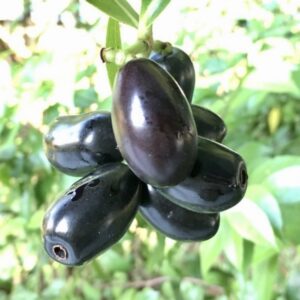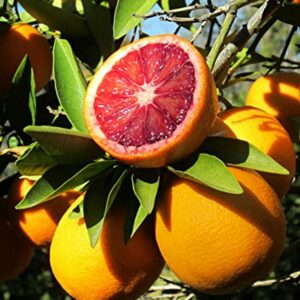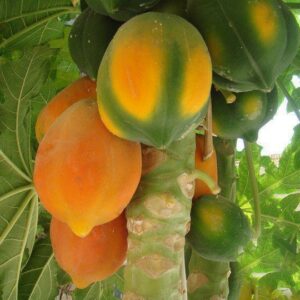Description
Passion Fruit scientifically known as Passiflora edulis is actually a shallow-rooted, tendril-climbing, evergreen vine that belongs to the family of Passifloraceae. It is also known as black passionfruit, maracuya, passion fruit, passionflower, purple granadilla, purple passion fruit, purple water lemon, qarandila and yellow passion fruit.
The plant is native to southern Brazil, Paraguay to northern Argentina, but is now grown in tropical and subtropical climates throughout the world. Genus name comes from the Latin words passio meaning passion and flos meaning a flower for the flower’s symbolism of the crucifixion of Christ.
Passion Fruit Plant Description
Passion fruit is a vigorous, herbaceous, perennial climber that grows about 0.5-2 m in length. The plants grows in tropical and subtropical mesic to wet environments especially forests and scrub, forest edges, forest gaps and riparian areas in forests and usually prefers well-drained soil with plenty of moisture in the growing season. Stem is slender, angular, striate, glabrous or puberulent.
passion Fruit Leaves
Leaves are alternate, in the form of a horseshoe or a ‘v’, with three main veins, coriaceous, with two divergent lobes, forming an angle of 45-93° between them, the lobes are oblanceolate, oblong, or linear, 2.2-6.5 × 0.4-1.4 cm, with rounded or acuminate apices, the base cuneate or rounded, the margin undulate, revolute; upper surface slightly leathery, glossy green or yellow-green; lower duller green, with prominent venation; petioles 3-5 mm long, canaliculate, without glands; stipules filiform, approximately 4 mm long; tendrils simple, filamentous. This vine clings to supports by coiled tendrils.
Passion Fruit Flower & Fruit
Flower is solitary, up to 7 cm in diameter. Sepals are oblong, green, 4-6 mm long and petals are pale green, oblong, as long as the sepals; corona of two series of filiform filaments, pale green, as long as the sepals; gynophore approximately 2 mm long, tubular; stamens 5; ovary claviform, the styles recurved, the stigmas capitate. Flowering takes place from Jul to August. Passion flowers are followed by fleshy berry, ovoid or globose, 1-1.4 cm long and 4-5 cm in diameter. The fruit is green when young turning to yellow, greenish-yellow or purplish as they mature. The fruit has tough outer rind which covers firm, juicy meat along with abundance of seeds. Fruit normally weights in between 35-50 g. Seeds are numerous, elliptical, small, hard, dark-brown or black, pitted, approximately 2.3 mm long, with transverse striae. Ripe fruits are edible off the vine or combined into a variety of food products such as beverages, jellies, fruit salads and sherbets. The fruit is both eaten and juiced; passion fruit juice is often added to other fruit juices to enhance aroma.
History of Passion Fruit
Purple and yellow passion fruit are native to Brazil. They were cultivated by the Aztecs, who prepared refreshments and drinks with them. It was introduced to Europe in 1629 thanks to the Spanish Jesuit missionaries. This fruit is hugely cultivated in Hawaii, Australia, South Africa, Venezuela, Brazil, Peru, Ecuador and Colombia. The sweet granadilla is cultivated all over South America, as well as in Hawaii and Kenya. The giant granadilla is mainly cultivated in the Andean area of South America and in Thailand, Indonesia and Malaysia. The cholupa is cultivated in South America. Finally, the banana passion fruit has a Colombian origin, from the Andean area.
The United Nations Agriculture and Food Organization (FAO) gathers the production and export data of different tropical fruit, among which are the carambola, cherimoya, feijoa, guava, mangosteen, passion fruit, rambutan, sapote, etc. Today it is grown throughout the world because of its unique taste and wonderful health benefits.

Health Benefits of Passion Fruit
Passion fruit is not only delicious as juice but also could be turned into several dishes and desserts. Furthermore, passion fruit is also rich of certain nutrients which makes this fruit is highly recommended to consume regularly. Below is the list of health benefits of passion fruit:
1. Prevents Cancer
Passion fruit is also a powerful source to enhance anti-carcinogenic activity in the body. Antioxidants in passion fruit mainly remove free radicals, which are known for mutating the DNA of healthy cells into cancerous ones. Passion fruit contains vitamin A, various flavonoids, and phenolic compounds, all of which have been linked to anti-cancer properties, particularly in terms of oral and lung cancers.(1)
2. Improves Bone Health
Passion fruit is a rich source of minerals like iron, copper, magnesium, and phosphorus. It is a very important fruit for increasing mineral bone density and bone strength. Some of these minerals are integral parts in creating additional bone matter, strengthening existing bone matter, and speeding up repair. This can be a means of eliminating, preventing or alleviating the symptoms of osteoporosis and the associated pain and inflammation that occurs when bones deteriorate with age and activity.
3. May Help Reduce Inflammation
Passion fruit peels consists of higher antioxidant content which give them powerful anti-inflammatory effects when they’re taken as a supplement. Research examined the effects of a purple passion fruit peel supplement on symptoms of asthma over four weeks and obtained a positive outcome.
Other research has examined the effects of purple passion fruit peel extract on joint pain and function in people with knee osteoarthritis. This is a painful condition caused by inflammation in the knee joint.
4. Younger looking skin
Antioxidants found abundantly in passion fruit are good for our skin. Passion fruit consists of antioxidants like Vitamin A, Vitamin C, riboflavin and carotene. These antioxidants reduce the production of free radicals in our body. Free radicals are generated by our body cells as a by-product and can cause skin aging. The anti-inflammatory properties of passion fruit tend to soothe our skin.
5. Treats Insomnia
Drinking a glass of cold passion fruit juice helps to relax our nerves and has a calming effect on the mind. Passion fruit is often used to cure digestive problems and gastric diseases. This fruit is beneficial for people with insomnia or sleeping disorders. It possesses somniferous properties, which when taken before going to bed, help you to relax and have a peaceful sleep. Glass of passion fruit juice before going to bed is quite effective in this regard.
6. Aids Digestion
Passion fruits are a good source of fiber, and a single serving provides the human body with approximately 98% of its daily requirement. Fiber is an essential component of a healthy diet since it is the substance that accelerates healthy digestion of food and the regulation of bowel movements. Passion fruit is a good source of soluble fiber, both in the pulp and in the rind, which acts as a bulk laxative, moving food through the digestive tract and reducing exposure time of the colon to any toxins. It also reduce signs of constipation by regulating bowel movements, scrubs the blood vessels clean of excess cholesterol, and even prevent gastrointestinal conditions like colorectal cancer!
7. Weight Loss
Passion fruit is a wonderful option for dieters as it is low in calories, sodium and fat. A 100 gram serving of passion fruit provides just 97 calories. It also has a high content of carbohydrates and natural sugars. These nutrients are effective in reducing cholesterol levels in the body. High fiber content, on the other hand, fills you up, thus reducing your cravings for other foods. This results in weight loss and maintenance of ideal body weight.
8. Improves Circulation
When combined with the vasodilation properties of potassium, the high iron and copper content of passion fruit can really make an impact. Iron and copper are both essential components of red blood cell production. Once the RBC count increases and the vessels are dilated, then healthy, oxygenated blood can flow freely to required parts of the body, encouraging the metabolic activity in all the organ systems and boosting productivity and efficiency. Healthy blood flow is necessary for proper functioning!
9. Soothes Respiratory Conditions
Recent research have shown that a combination of several extracts from the purple passion fruit peel creates a new mixture of bioflavonoids, which have an expectorant, sedative, and soothing effect on the respiratory system. It has been positively connected to a reduction in asthma attacks, wheezing, and whooping cough.
10. Reduce the Risk of Arthritis
Beta carotene found abundantly in passion fruit has the ability to reduce the risk of arthritis. Arthritis is a condition whereas there is inflammation in the joint and beta-carotene in passion fruit is not a magic solution to deal with this condition.
11. Cardiovascular Health
Passion fruit consists of good amount of phenolic acids and flavonoids that helps in protecting your heart. Polyphenols found in seeds have been found to promote vasorelaxation i.e. extending of blood vessels as a result of relaxation of smooth muscle cells inside the blood vessel walls. This extension of blood vessels causes a reduction in vascular stress, thus promoting heart health. It also contains plant sterols that help in lowering the cholesterol levels, thus contributing to cardiovascular benefits.
12. Good for Eye health and Vision
As we all know that any fruits or vegetables that contain vitamin A will be good for eye health and vision. Additionally, flavonoid, one of the active antioxidant is also found adequately in passion fruit. Flavonoid is widely known as powerful substances which are beneficial for eye health; it provides additional protection to the cornea and assists in taking care free radicals that could cause some harmful effect to healthy cells.
13. Helpful in Curing Anemia
Anemia is caused due to reduced concentrations of red blood cells or hemoglobin. Passion fruit, being a rich source of non-heme or plant-based iron can help to combat this problem. A cup of raw passion fruit provides nearly 4 milligrams of iron. The daily requirement is 6 micrograms for men and 8.1 micrograms for women. Besides, the Vitamin C in passion fruit helps the body soak up its iron content.
14. Boosts Immunity
Passion fruit consist of huge amount of vitamin C, carotene, and cryptoxanthin which are actually immune strengthening elements. A single serving of passion fruit (100 grams) provides about 30 mg of vitamin C. All of these vitamins act as antioxidants, which hunt free radicals from the body and neutralize them before they can harm the organ systems and result in conditions like cancer, heart disease, or premature aging. Furthermore, vitamin C stimulates the activity of white blood cells and the rest of the immune defense system, thereby protecting you from common illnesses and serious diseases at the same time.
15. Maintain the Healthy Hair
Potassium together with copper and combined with some vitamins like vitamin A, vitamin C, vitamin B2 and vitamin B6 will provide great solution for healthy hair. They will help to distribute oxygen to support the circulation system in your scalp. Healthy scalp means healthy follicles, healthy follicles means healthier and stronger hair.
16. Reduces Blood Pressure
If you eat one serving of passion fruit each day, you can satisfy 1/4 of your potassium needs instantly. Potassium is a vital mineral in the human body for a number of reasons, one of which is its role as a vasodilator. It relaxes the tension of blood vessels and promotes increased blood flow. This reduces the strain on the heart and increases overall cardiovascular health. Furthermore, potassium is necessary to maintain the proper fluid balance of the body’s cells. Movement between membranes is often only allowed through potassium-regulated channels, so proper amounts of this mineral are of extreme importance. So make sure you pop a passion fruit into your lunch once in a while to keep your heart healthy and your cells functioning!
17. Relieves Asthma
Being highly nutritious and healthy, passion fruit can soothe asthma attacks. Moreover, it contains Vitamin C which has a blocking effect of histamine that causes asthma symptoms. A recent research has proved that the purple passion fruit extract, being rich in flavonoids, can ease wheezing.







Reviews
There are no reviews yet.